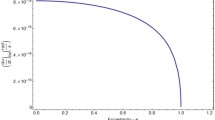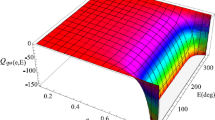Abstract
The results of theoretical studies of the influence of Yukawa-type additions to a Newtonian gravitational potential on the perihelion precession of bodies in the solar system are presented. An expression for the precession angle due to such additions is obtained. It is shown that, with certain relationships between the parameters in the Yukawa potential, their contribution to the perihelion precession of the trans-Neptunian objects 2000 OO67, 2006 SQ372, 2009 FW54, 2013 BL76, and 2003 VB12 is of order 0.01″ over the period, exceeding the contribution of general relativistic terms by at least an order of magnitude. The fundamental possibility of perihelion precession of these trans-Neptunian objects in the retrograde direction is established. Observational data on the precession of planets in the solar system are used to place constraints on the parameters of the added Yukawa potential.
Similar content being viewed by others
References
V. G. Turyshev, Phys. Usp. 52, 1 (2009).
J. R. Brownstein, arXiv:0908.0040 (2009).
S. O. Alekseev, E. A. Pamyatnykh, A. V. Ursulov, D. A. Tret’yakova, and K. A. Rannu, Introduction to the General Theory of Relativity, and Its Current Development and Applications (Ural. Univ., Ekaterinburg, 2015) [in Russian].
A. Stabile and S. Capozzielo, Phys. Rev. D 87, 064002 (2013).
T. P. Sotiriou, Rev. Mod. Phys. 82, 451 (2010).
J. L. Cervantes-Cota, M. A. Rodriguez-Meza, R. Gabbasov, and J. Klapp, Rev. Mex. Fis. 53, S22 (2007).
J. W. Moffat, J. Cosmol. Astropart. Phys. 0603, 004 (2006).
J. W. Moffat, Int. J. Mod. Phys. D16, 2075 (2008).
B. Jain, V. Vikram, and J. Sakstein, arXiv:1204.6044 (2012).
T. Cliftona, P. G. Ferreira, A. Padilla, and C. Skordis, Phys. Rep. 513, 1 (2012).
D. Clowe, M. Bradac, A. H. Gonzalez, M. Markevitch, S. W. Rand all, C. Jones, and D. Zaritsky, Astrophys. J. 648, L109 (2006).
L. Iorio, J. High Energy Phys. 10, 041 (2007).
C. P. L. Berry and J. R. Gair, Phys. Rev. D 83, 104022 (2011).
B. Lamine, J.-M. Courty, S. Reynaud, and M.-T. Jaekel, arXiv:1105.6269 (2011).
L. Iorio, J. High Energy Phys. 5, 73 (2012).
B. Buscaino, D. DeBra, P. W. Graham, G. Gratta, and T. D. Wiser, Phys. Rev. D 92, 104048 (2015).
F. F. Faria, arXiv:1604.02210 (2016).
V. F. Cardone and S. Capozziello, Mon. Not. R. Astron. Soc. 414, 1301 (2011).
S. O. Alexeyev, K. A. Rannu, P. I. Dyadina, B. N. Latosh, and S. G. Turyshev, J. Exp. Theor. Phys. 120, 966 (2015).
S. Reynaud and M.-T. Jaekel, Int. J. Mod. Phys. A 20, 2294 (2005).
L. Iorio, arXiv:0809.3563 (2008).
L. Iorio, arXiv:0905.4704 (2009).
Z. Berezhiani, L. Pilo, and N. Rossi, Eur. Phys. J. C 70, 305 (2010).
R. H. Sanders, Astron. Astrophys. 136, L21 (1984).
H. Haghi and S. Rahvar, Int. J. Theor. Phys. 49, 1004 (2010).
D. S. L. Soares, Rev. Mex. Astron. Astrofis. 28, 35 (1994).
V. Salzano, D. F. Mota, S. Capozziello, and N. R. Napolitano, Astron. Astrophys. 561, A131 (2014).
N. R. Napolitano, S. Capozziello, A. J. Romanowsky, M. Capaccioli, and C. Tortora, Astrophys. J. 748, 87 (2012).
I. de Martino, M. de Laurentis, F. Atrio-Barandela, and S. Capozziello, Mon. Not. R. Astron. Soc. 442, 921 (2014).
C. S. S. Brandao and J. C. N. de Araujo, Gen. Rel. Grav. 42, 777 (2010).
C. S. S. Brandao and J. C. N. de Araujo, Gen. Rel. Grav. 42, 623 (2010).
Z. Berezhiani, F. Nesti, L. Pilo, and N. Rossi, J. High Energy Phys. 0907, 083 (2009).
M. C. Martino, H. F. Stabenau, and R. K. Sheth, Phys. Rev. D 79, 084013 (2009).
C. S. S. Brandao and J. C. N. de Araujo, Astrophys. J. 750, 29 (2012).
I. de Martino, M. de Laurentis, and S. Capozziello, Universe 1 (2), 123 (2015).
I. de Martino, M. de Laurentis, F. Atrio-Barandela, and S. Capozziello, J. Phys.: Conf. Ser. 600, 012048 (2015).
L. D. Land au and E. M. Lifshitz, Course of Theoretical Physics, Vol. 1: Mechanics (Pergamon, New York, 1988; Fizmatlit, Moscow, 2012).
L. D. Landau and E. M. Lifshitz, Course of Theoretical Physics, Vol. 2: The Classical Theory of Fields (Fizmatlit, Moscow, 2012; Pergamon, Oxford, 1975).
K. Batygin and M. E. Brown, Astron. J. 151, 22 (2016).
V. S. Beskin, Gravity and Astrophysics (Fizmatlit, Moscow, 2009) [in Russian].
Author information
Authors and Affiliations
Corresponding author
Additional information
Original Russian Text © A.V. Ursulov, T.V. Chuvasheva, 2017, published in Astronomicheskii Zhurnal, 2017, Vol. 94, No. 5, pp. 467–474.
Rights and permissions
About this article
Cite this article
Ursulov, A.V., Chuvasheva, T.V. Influence of Yukawa-type additions to a Newtonian gravitational potential on the perihelion precession of bodies in the solar system. Astron. Rep. 61, 468–474 (2017). https://doi.org/10.1134/S1063772917050092
Received:
Accepted:
Published:
Issue Date:
DOI: https://doi.org/10.1134/S1063772917050092




